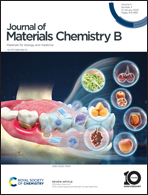Recent advances of graphene–biomacromolecule nanocomposites in medical applications
Abstract
In recent years, graphene-based composites have received increasing attention due to their high biocompatibility, large specific surface area, high electrical conductivity and unique mechanical properties. The combination of biomacromolecules and graphene provides a promising route for the preparation of novel graphene-based nanocomposites. Novel graphene-based nanocomposites with unique functions could be applied to medicine, biology, biosensors, environmental science, energy storage and other fields. Graphene–biomacromolecule nanocomposites have excellent biocompatibility, outstanding biofunctionality and low cytotoxicity, and have more advantages and development prospects than other traditional graphene-based materials in biological and biomedical fields. In this work, we summarize the research on the covalent and non-covalent interactions between different biomacromolecules (peptides, DNA/RNA, proteins and enzymes) and graphene, as well as the synthesis methods of novel functionalized graphene–biomacromolecule composites in recent years. We mainly introduce the recent advances (last 5 years) of graphene–biomacromolecule nanocomposites in medical applications, such as medical detection and disease treatment. We hope that this review will help readers to understand the methods and mechanisms of biomolecules modifying the surface of graphene, as well as the synthesis and application of graphene-based nanocomposites, which will promote the future developments of graphene–biomolecule composites in biomedicine, tissue engineering, materials engineering, and so on.

- This article is part of the themed collection: Journal of Materials Chemistry B Recent Review Articles


 Please wait while we load your content...
Please wait while we load your content...